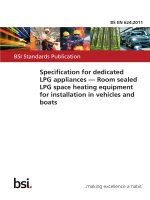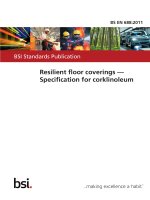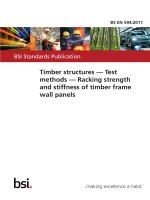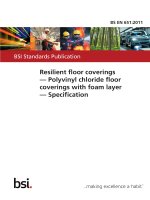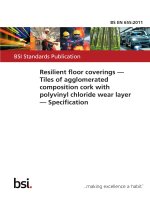Bsi bs en 62458 2011
Bạn đang xem bản rút gọn của tài liệu. Xem và tải ngay bản đầy đủ của tài liệu tại đây (1.35 MB, 28 trang )
BS EN 62458:2011
BSI Standards Publication
Sound system equipment —
Electroacoustic transducers —
Measurement of large signal
parameters
NO COPYING WITHOUT BSI PERMISSION EXCEPT AS PERMITTED BY COPYRIGHT LAW
raising standards worldwide™
BRITISH STANDARD
BS EN 62458:2011
National foreword
This British Standard is the UK implementation of EN 62458:2011. It is
identical to IEC 62458:2010.
The UK participation in its preparation was entrusted to Technical Committee
EPL/100, Audio, video and multimedia systems and equipment.
A list of organizations represented on this committee can be obtained on
request to its secretary.
This publication does not purport to include all the necessary provisions of a
contract. Users are responsible for its correct application.
© BSI 2011
ISBN 978 0 580 62423 0
ICS 33.160.50
Compliance with a British Standard cannot confer immunity from
legal obligations.
This British Standard was published under the authority of the Standards
Policy and Strategy Committee on 30 June 2011.
Amendments issued since publication
Amd. No.
Date
Text affected
BS EN 62458:2011
EUROPEAN STANDARD
EN 62458
NORME EUROPÉENNE
March 2011
EUROPÄISCHE NORM
ICS 33.160.50
English version
Sound system equipment Electroacoustic transducers Measurement of large signal parameters
(IEC 62458:2010)
Equipements pour systèmes
électroacoustiques Transducteurs électroacoustiques Mesure des paramètres en grand signal
(CEI 62458:2010)
Elektroakustische Geräte Elektroakustische Wandler Messung von Großsignal-Parametern
(IEC 62458:2010)
This European Standard was approved by CENELEC on 2011-01-02. CENELEC members are bound to comply
with the CEN/CENELEC Internal Regulations which stipulate the conditions for giving this European Standard
the status of a national standard without any alteration.
Up-to-date lists and bibliographical references concerning such national standards may be obtained on
application to the Central Secretariat or to any CENELEC member.
This European Standard exists in three official versions (English, French, German). A version in any other
language made by translation under the responsibility of a CENELEC member into its own language and notified
to the Central Secretariat has the same status as the official versions.
CENELEC members are the national electrotechnical committees of Austria, Belgium, Bulgaria, Croatia, Cyprus,
the Czech Republic, Denmark, Estonia, Finland, France, Germany, Greece, Hungary, Iceland, Ireland, Italy,
Latvia, Lithuania, Luxembourg, Malta, the Netherlands, Norway, Poland, Portugal, Romania, Slovakia, Slovenia,
Spain, Sweden, Switzerland and the United Kingdom.
CENELEC
European Committee for Electrotechnical Standardization
Comité Européen de Normalisation Electrotechnique
Europäisches Komitee für Elektrotechnische Normung
Management Centre: Avenue Marnix 17, B - 1000 Brussels
© 2011 CENELEC - All rights of exploitation in any form and by any means reserved worldwide for CENELEC members.
Ref. No. EN 62458:2011 E
BS EN 62458:2011
EN 62458:2011
-2-
Foreword
The text of document 100/1624/FDIS, future edition 1 of IEC 62458, prepared by IEC/TC 100, Audio,
video and multimedia systems and equipment, was submitted to the IEC-CENELEC parallel vote and was
approved by CENELEC as EN 62458 on 2011-01-02.
Attention is drawn to the possibility that some of the elements of this document may be the subject of
patent rights. CEN and CENELEC shall not be held responsible for identifying any or all such patent
rights.
The following dates were fixed:
– latest date by which the EN has to be implemented
at national level by publication of an identical
national standard or by endorsement
(dop)
2011-10-02
– latest date by which the national standards conflicting
with the EN have to be withdrawn
(dow)
2014-01-02
Annex ZA has been added by CENELEC.
__________
Endorsement notice
The text of the International Standard IEC 62458:2010 was approved by CENELEC as a European
Standard without any modification.
__________
BS EN 62458:2011
-3-
EN 62458:2011
Annex ZA
(normative)
Normative references to international publications
with their corresponding European publications
The following referenced documents are indispensable for the application of this document. For dated
references, only the edition cited applies. For undated references, the latest edition of the referenced
document (including any amendments) applies.
NOTE When an international publication has been modified by common modifications, indicated by (mod), the relevant EN/HD
applies.
Publication
Year
Title
EN/HD
Year
IEC 60268-1
-
Sound system equipment Part 1: General
HD 483.1 S2
-
IEC 60268-5
A1
2003
2007
Sound system equipment Part 5: Loudspeakers
EN 60268-5
A1
2003
2009
BS EN 62458:2011
–2–
62458 © IEC:2010(E)
CONTENTS
INTRODUCTION.....................................................................................................................6
1
Scope ...............................................................................................................................7
2
Normative references .......................................................................................................7
3
Terms and definitions .......................................................................................................7
4
Test signals ......................................................................................................................9
5
4.1 General ...................................................................................................................9
4.2 Large d.c. signal......................................................................................................9
4.3 Large d.c. signal and small a.c. signal .....................................................................9
4.4 Broadband noise signal ...........................................................................................9
4.5 Music ......................................................................................................................9
Mounting condition ......................................................................................................... 10
6
5.1 Drive units ............................................................................................................. 10
5.2 Loudspeaker systems ............................................................................................ 10
Climatic conditions ......................................................................................................... 10
7
Acoustical environment .................................................................................................. 10
8
Preconditioning .............................................................................................................. 10
9
Time-varying properties of the loudspeaker .................................................................... 11
10 Methods of measurement ............................................................................................... 11
10.1 General ................................................................................................................. 11
10.2 Static or quasi-static method ................................................................................. 11
10.3 Point-by-point dynamic method ............................................................................. 12
10.4 Full dynamic method ............................................................................................. 14
11 Nonlinear force factor ..................................................................................................... 15
11.1 Force factor curve Bl(x) ......................................................................................... 15
11.2 Force-factor limited displacement, X Bl ................................................................... 16
11.3 Symmetry point, x sym (x ac )...................................................................................... 17
11.4 Voice coil offset, x offset .......................................................................................... 18
12 Nonlinear stiffness.......................................................................................................... 18
12.1 Nonlinear stiffness curve K ms (x) ............................................................................ 18
12.2 Compliance-limited displacement x C ...................................................................... 19
12.3 Stiffness asymmetry A K (x peak ).............................................................................. 19
13 Displacement-dependent inductance, L e (x) ..................................................................... 20
13.1 Inductance curve L e (x) .......................................................................................... 20
13.2 Inductance-limited displacement, x L ...................................................................... 21
14 Current -dependent inductance, L e (i).............................................................................. 21
14.1 Characteristic to be specified ................................................................................ 21
14.2 Method of measurement ........................................................................................ 21
15 Parameters derived from geometry and performance...................................................... 22
15.1 Maximal peak displacement, x MAXd ....................................................................... 22
15.2 Method of measurement ........................................................................................ 22
Bibliography.......................................................................................................................... 23
Figure 1 – Electro-dynamical transducer .................................................................................7
BS EN 62458:2011
62458 © IEC:2010(E)
–3–
Figure 2 –Static and quasi-static measurement setup ........................................................... 12
Figure 3 – Setup for measurement of large signal parameters by using the point-bypoint dynamic method ........................................................................................................... 13
Figure 4 – Setup for dynamic measurement of large signal parameters................................. 14
Figure 5 – Reading the maximal peak displacement x B limited by force factor only ............... 16
Figure 6 – Reading the voice coil offset from the symmetry point x sym (x ac ) curve .................. 17
Figure 7 – Definition of the symmetry point x sym in the nonlinear force factor
characteristic Bl(x) ................................................................................................................ 18
Figure 8 – Reading the stiffness asymmetry from the K ms (x) curve ....................................... 20
BS EN 62458:2011
–6–
62458 © IEC:2010(E)
INTRODUCTION
Electro-mechanical-acoustical transducers such as loudspeaker drive units, loudspeaker
systems, headphones, micro-speakers, shakers, and other actuators behave in a nonlinear
manner at higher amplitudes. This limits the acoustical output and generates nonlinear signal
distortion. Linear models fail in describing the large signal behaviour of such transducers and
extended models have been developed which consider dominant nonlinearities in the motor
and suspension. The free parameters of the large signal model have to be measured on the
particular transducer by using static or dynamic methods. The large signal parameters show
the physical cause of the signal distortion directly and are very important for the objective
assessment of sound quality and failure diagnostics in development and manufacturing.
Furthermore, the model and parameters identified for a particular transducer are the basis for
predicting the maximum output and signal distortion for any input signal. The close
relationship between causes and symptoms simplifies the interpretation of the harmonic and
intermodulation distortion measured according to IEC 60268-5. Large signal parameters are
valuable input data for the synthesis of loudspeaker systems and the development of
electrical control systems dedicated to loudspeakers.
BS EN 62458:2011
62458 © IEC:2010(E)
–7–
SOUND SYSTEM EQUIPMENT –
ELECTROACOUSTICAL TRANSDUCERS –
MEASUREMENT OF LARGE SIGNAL PARAMETERS
1
Scope
This International Standard applies to transducers such as loudspeaker drive units,
loudspeaker systems, headphones, micro-speakers, shakers and other actuators using either
an electro-dynamical or electro-magnetic motor coupled with a mechanical suspension. The
large signal behaviour of the transducer is modelled by a lumped parameter model
considering dominant nonlinearities such as force factor, stiffness and inductance as shown in
Figure 1. The standard defines the basic terms and parameters of the model, the methods of
measurements and the way the results should be reported.
2
Normative references
The following referenced documents are indispensable for the application of this document.
For dated references, only the edition cited applies. For undated references, the latest edition
of the referenced document (including any amendments) applies.
IEC 60268-1, Sound system equipment – Part 1: General
IEC 60268-5:2003, Sound system equipment – Part 5: Loudspeakers
Amendment 1 (2007)
3
Terms and definitions
For the purposes of this document, the following terms and definitions apply.
3.1
electro-mechanical equivalent circuit
electrical circuit of an electro-dynamical transducer, as shown in Figure 1
Re(TV)
Le(x, i)
i3
L2(x, i3)
Fm
Cms (x)
Mms
Rms
v
i
i2
u
R2(x, i2)
Bl(x) v
Bl(x)
Bl(x) i
Zload
IEC 2511/09
NOTE 1 This Figure shows an example of a lumped parameter model of an electro-dynamical transducer
considering the dominant nonlinearities.
NOTE 2 Other equivalent circuits can be applied. Contrary to the results of linear modelling some parameters of
the lumped elements are not constant but depend on instantaneous state variables (such as displacement x,
velocity v, current i).
Figure 1 – Electro-dynamical transducer
BS EN 62458:2011
62458 © IEC:2010(E)
–8–
3.2
input current and voltage
i, u
electrical state variables at the terminals of the transducer
3.3 displacement
x
deflection of the voice coil from the rest position
3.4
velocity
v
time derivative of displacement x
3.5
d.c. resistance
Re
electrical impedance Z e(s) at very low frequencies where the effect of the back EMF can be
neglected
NOTE Electrical impedance can be used for measuring the d.c. resistance R e of the voice coil. The d.c. resistance
R e depends on the mean voice coil temperature T V .
3.6
nonlinear inductance and losses
nonlinear elements to model the effect of the magnetic a.c. field, the losses in the magnetic
material, and the losses caused by eddy currents where the equivalent circuit in Figure 1 uses
the LR-2 model comprising the inductance L e(x, i), the inductance L 2 (x, i 2 ) and additional
resistance R 2 (x, i 3 )
3.7
nonlinear force factor
Bl(x)
dependency of instantaneous force factor Bl(x) on voice coil displacement x defined by the
integral of magnetic flux density B versus the voice-coil conductor of length l
NOTE The product of force factor Bl(x) and velocity v is the back EMF generated on the electrical side in an
equivalent circuit as shown in Figure 1. The product of force factor Bl(x) and input current i gives the electrodynamical driving force of the mechanical system.
3.8
reluctance force
Fm
additional electro-magnetic driving force caused by the displacement varying inductances
L e(x, i) and L 2 (x, i 2 )
3.9
stiffness, K ms (x), of the suspension
ratio between the instantaneous restoring force F(x) and the displacement x as given by
K ms (x ) =
NOTE
F (x )
x
The nonlinear compliance C ms (x) = 1/K ms (x) is the reciprocal quantity of the mechanical stiffness.
(1)
BS EN 62458:2011
62458 © IEC:2010(E)
–9–
3.10
mechanical mass
M ms
total moving mass including the mass of the moving assembly and the reactive part of the air
load on both sides of the diaphragm
3.11
mechanical resistance
R ms
non-electrical losses of the driver, due to suspension, turbulences and radiation
3.12
mechanical impedance
Z load
mechanical impedance which may represent any additional load caused by mechanical
elements (cone, panel) or acoustical elements (such as a vented enclosure or horn)
4
4.1
Test signals
General
The measurement of the large signal parameters requires an electrical, mechanical or
acoustical stimulus. Depending on the method used for the measurement of the large signal
parameters different kind of test signals are used as stimulus for the excitation of the
transducer. Since the loudspeaker behaves as a time-varying system the stimulus may cause
a permanent or temporary change of the loudspeaker properties. Thus, the properties of the
stimulus (spectral bandwidth, crest factor, proability density function) shall be statet. The
same stimulus should be used if the numerical values of the results should be compared from
two measurements.
4.2
Large d.c. signal
A constant d.c. voltage or d.c current of defined magnitude and sufficient duration is supplied
to the electrical terminals to measure the steady-state response of the transducer. If the
transducer is mounted in a sealed enclosure a difference between the static air pressures
inside and outside the enclosure may be used as d.c. stimulus.
4.3
Large d.c. signal and small a.c. signal
A constant d.c. signal of defined magnitude and sufficient duration (see 4.2) superimposed
with a small a.c. signal is used as stimulus. The a.c. signal (such as noise, sinusoidal sweep,
impulsive test signals) should have sufficient bandwidth to identify all parameters of the
loudspeaker model.
4.4
Broadband noise signal
One of the noise signals defined in IEC 60268-1 or any other noise having sufficient
bandwidth and amplitude may be used as stimulus. The crest factor of the noise should be
less than 4 to reduce clipping in the amplifier.
4.5 Music
Ordinary music, speech of sufficient bandwidth and amplitude may be used as a stimulus.
NOTE The dynamic methods need a stimulus which provides persistent excitation of the loudspeaker to identify
the parameters correctly. The stimulus should have enough spectral components at least one octave below
resonance frequency f s and one decade above f s .
BS EN 62458:2011
– 10 –
5
62458 © IEC:2010(E)
Mounting condition
5.1
Drive units
The driver unit may be mounted
a) in free air without a baffle or enclosure,
b) in a standard baffle according to 11.1 of IEC 60268-5,
c) in half-space free field according to 5.2 of IEC 60268-5,
d) in the standard measuring enclosure (type A or type B) according to 11.2 of
IEC 60268-5, or another, specified enclosure,
e) in vacuum,
f)
other configuration defined in the presentation of the results.
The acoustic loading depends upon the mounting arrangement, which shall be clearly
described in the presentation of the results.
During the measurement the transducer should be firmly clamped to suppress additional
mechanical resonances close to the resonance frequency f s . A vertical position of the
transducer (cone displacement in horizontal direction) is recommended to avoid any bias due
the weight of the moving assembly.
Drive units for horn loaded loudspeakers, headphones, micro-speakers and microphones
should preferably be measured in a vacuum to reduce the acoustic load, suppress additional
acoustic resonances, and to avoid nonlinear damping due to turbulent air flow.
5.2
Loudspeaker systems
Loudspeaker systems are measured under conditions which correspond with the intended use.
6
Climatic conditions
The measurements should be made at an ambient temperature 15°C to 35°C, preferably at
20°C, relative humidity 25 % to 75 %, air pressure 86 kPa to 106 kPa as specified in
IEC 60268-1 to avoid any influence of temperature and humidity that may affect the properties
of the drive unit suspensions.
7
Acoustical environment
The measurement room shall be large enough that the influence of the acoustical environment
on the mechanical vibration of the transducer is negligible.
If the measurement of the large signal parameters is based on sound pressure output it is
recommended to place the measuring microphone in the near field of the transducer. It is
recommended to use a method that measures electrical or mechanical signals only, which is
thus immune to unwanted acoustic noise.
8
Preconditioning
The loudspeaker should be preconditioned according to Clause 12 of IEC 60268-5. A
temporary voice coil offset caused by storing the transducer for some time in the horizontal
position can be removed by operating the transducer for at least 5 min in the vertical position
before performing the regular measurement.
BS EN 62458:2011
62458 © IEC:2010(E)
9
– 11 –
Time-varying properties of the loudspeaker
The stimulus provided to the electrical input of the loudspeaker may cause a heating of the
voice coil and may also change the properties of the suspension during measurement. Thus,
the electrical resistance of the coil should be measured during measurement and considered
in the calculation of the loudspeaker parameters (e.g. electrical loss factor Q es ).
10 Methods of measurement
10.1
General
The following methods may be used for the measurement of the large signal parameters. The
method used should be stated together with the results.
10.2
10.2.1
Static or quasi-static method
General
This technique determines the non-linear parameters of the transducer by using a d.c. signal
with magnitude u i (usually voltage) as stimulus. After reaching steady state relevant state
variables (d.c. displacement x i , d.c. force F i ) are measured and the parameter value (such as
K( x i ) = F i / x i ) is calculated. After changing the magnitude of the d.c. signal the measurement is
repeated at further working points x i with i = 1, …, N to measure the non-linear parameters
within the working range – x peak < x i < x peak with sufficient resolution.
Due to the visco-elastic behaviour of the suspension material, the settling time required to
reach steady state may exceed several seconds and a static method is very time consuming.
In a quasi-static method the state variables are measured before steady state is reached and
the settling time used should be stated.
Creep and other visco-elastic properties of the suspension cause significant discrepancies
between the stiffness K( x ) measured statically by using a d.c. signal and the stiffness Kms ( x )
measured dynamically by using an broadband noise signal.
The d.c. signal of the static and quasi-static methods cannot be used for the measurement of
the nonlinear voice coil inductance L e ( x, i ). Figure 2 shows a setup for static and quasi-static
measurement of large signal parameters.
BS EN 62458:2011
62458 © IEC:2010(E)
– 12 –
Transducer
DC signal
generator
Sensor
ui
Input
signal
Parameter
calculation
Measured
signal
Parameter value
at working point ui
Selection of working
point
Large signal
parameters
IEC 2512/09
Figure 2 –Static and quasi-static measurement setup
10.2.2
Procedure
Proceed as follows.
a)
According to the limits of working range – x peak < x i < x peak investigated and the resolution
required, the number of measurements N is determined, a starting voltage u start is
selected and the incremental voltage u step is defined.
b)
The first working point i = 1 is initialized.
c)
The transducer is excited by a d.c. signal voltage u i = u start + i × u step .
At the working point, i , the displacement, x i , and other relevant state variables (such as
force F i ) are measured after the transducer has reached steady state or a defined settling
time T has passed.
d)
e)
f)
g)
The nonlinear parameter (for example, K( x i ) = F i / x i ) is calculated.
The next working point i = i + 1 is selected and previous steps 1 to 5 are repeated until
i > N.
The parameter values are interpolated between the working points x i with i = 1 , …, N or
the coefficients of the power series expansion (such as Equation (3)) are calculated.
10.3
10.3.1
Point-by-point dynamic method
General
This technique determines the non-linear parameters of the transducer with a d.c. signal, u i
(such as d.c. voltage or a constant air pressure), superimposed with a small a.c. signal, u ac ,
as stimulus. After reaching the steady state, the relevant state variables (d.c. displacement x i
and the amplitudes of the a.c. force F ac and a.c. displacement x ac ) are measured and the
parameter value (such as the incremental stiffness K inc ( x i ) = F ac / x ac ) is calculated. After
changing the magnitude of the d.c. part of the stimulus the measurement is repeated at
further working points x i with i = 1 , …, N, to measure the non-linear parameters within the
working range – x peak < x i < x peak with sufficient resolution.
BS EN 62458:2011
62458 © IEC:2010(E)
– 13 –
The amplitude u ac of the a.c. stimulus is sufficiently small to ensure that the transducer
behaves linearly ( K( x i + x ac ) ≈ constant, Bl ( x i + x ac ) ≈ constant and L e ( x i + x ac ) ≈ constant)
and a linear loudspeaker model can be applied.
Whereas some small signal parameters (force factor Bl ( x i ) and inductance L e( x i )) are identical
to the large signal parameters measured by other methods, this technique provides the
incremental stiffness, Kinc ( x i ), which can only be transformed into the regular stiffness by
integration
K (x ) =
1
x
x
∫ K inc (x)dx
(2)
0
Due to the visco-elastic behaviour of the suspension material, there are significant differences
between the stiffness K( x ) measured by the point-by-point method using a d.c. signal and the
stiffness Kms(x) measured dynamically with a program like an a.c. signal. Figure 3 shows a
setup for point-by-point dynamic measurement of large signal parameters.
10.3.2
Test equipment
The stimulus comprising a d.c part and an a.c. part can be produced by using a generator
with a d.c. offset and a d.c.-coupled power amplifier. However, providing the d.c. part via the
electrical input produces significant heating of the voice coil at high amplitudes. Alternatively,
the transducer may be mounted in a sealed box, and the voice coil position may be varied by
changing the d.c. air pressure inside the box.
AC signal
generator
Measured
signal
uac
Transducer
Sensor
Error
signal
i (t)
u (t)
e (t)
i′ (t)
DC signal
generator
ui
Input
signal
Linear
model
Estimated
signal
Optimal
parameter
fitting
Smal signal parameters
at working point ui
Selection of working
point
Large signal
parameters
IEC 2513/09
Figure 3 – Setup for measurement of large signal parameters
by using the point-by-point dynamic method
BS EN 62458:2011
62458 © IEC:2010(E)
– 14 –
10.3.3
Procedure
According to the limits of working range – x peak < x i < x peak investigated and the resolution
required, the number of measurements N , starting voltage u start and incremental voltage u step
is defined. The first working point i = 1 is selected.
Proceed as follows.
a) The transducer is excited by a stimulus u i + u ac = u start + i × u step + u ac .
b) At working point, i , the d.c. displacement, x i , and a.c. state variables (such as a.c force
F ac and a.c. displacement x ac ) are measured after the transducer has reached steady
state or a defined settling time T has passed.
c) The small signal parameters (such as Kinc ( x i ) = F ac / x ac ) are calculated at the particular
working point x i by using a linear model which is optimally fitted to the measured signal.
d) The next working point i = i + 1 is selected and steps 1 to 5 are repeated until i > N.
e) The parameter values are interpolated between the working points x i with i = 1, …, N or
the coefficients of the power series expansion (such as Equation (3)) are calculated.
10.4
10.4.1
Full dynamic method
General
The full dynamic method uses an a.c. stimulus of sufficient amplitude and bandwidth such as
music or an audio-like signal (noise). Usually, there is no d.c. component in the stimulus.
Measured state variables (voltage, current, displacement) are the basis for the identification
of free parameters of the non-linear model (such as the lumped model in Figure 1). Based on
identified state variables (such as voice coil temperature) and transducer nonlinearities
(stiffness Kms ) the amplitude of the stimulus is adjusted automatically to operate the
transducer at maximal amplitudes – x peak < x i < x peak safely and to avoid any damage of the
transducer. Figure 4 shows the setup for dynamic measurement of large signal parameters.
Measured
signal
Gain
control
Transducer
Power
amplifier
AC signal
generator
Sensor
Error
signal
i (t)
u (t)
e (t)
i′ (t)
Input
signal
Nonlinear
model
Estimated
signal
Optimal
parameter
fitting
Selection of working
range
Large signal
parameters
IEC 2514/09
Figure 4 – Setup for dynamic measurement of large signal parameters
BS EN 62458:2011
62458 © IEC:2010(E)
10.4.2
– 15 –
Requirements
A signal source is required providing an audio-like signal which is provided via a power
amplifier to the loudspeaker terminals. A sensor is required to monitor at least one state
variable (such as current) of the loudspeaker. A signal processing system is required to model
the relationship between input signal (such as voltage) and monitored state variable (such as
current) and to calculate the optimal parameters by using a fitting technique.
10.4.3
Procedure
Proceed as follows.
a) A broadband noise signal of small amplitude is supplied via a power amplifier to the
terminals of the speaker (voltage supply).
b) The electrical input current i at the terminals or other state signals (displacement or sound
pressure) is measured using a mechanical or acoustical sensor.
c) The input current i ’( t ) is predicted using the nonlinear transducer model (such as lumped
model in Figure 1). The error signal e ( t ) = i( t ) – i’( t ) is calculated and the free parameters
are estimated by minimizing the error signal e ( t ).
d) The displacement limits x Bl and x C are derived from Equations (4) and (7). The increase of
the voice coil temperature ΔT V is estimated by monitoring the d.c. resistance R e of the coil.
e) The amplitude of the stimulus is increased until the peak displacement x peak exceeds
either the force factor limited displacement, x Bl, or the compliance limited displacement, x C
or the increase of the voice coil temperature ΔT V exceeds the permissible limits.
f)
Adequacy of the modeling and optimal parameter fitting shall be checked by calculating
the mean squared error between measured and modeled response (such as current,
velocity, displacement).
11 Nonlinear force factor
11.1
Force factor curve Bl(x)
11.1.1
Characteristic to be specified
The non-linear force factor, Bl ( x ), is preferably reported as a graphical representation showing
the parameter as a function of displacement, x , within the measured range – x peak < x < x peak
Positive displacement, x , corresponds to a deflection of the coil away from the back-plate. It is
recommended that the displacement axis is labelled with verbal comments to support the
orientation of the coil-in and coil-out position.
11.1.2
11.1.2.1
Method of measurement
General
The force factor characteristic may be measured by the static, point-by-point dynamic or the
full dynamic method as defined in Clause 10. The method used shall be reported.
11.1.2.2
Coefficients of force factor expansion
The coefficients b j with j = 0, 1, …, N in the power series expansion of the force factor curve
Bl (x ) =
N
∑b j x j
(3)
j =0
shall be reported with peak displacement x peak describing the limits of the fitting range
− x peak < x < x peak .
BS EN 62458:2011
62458 © IEC:2010(E)
– 16 –
11.2
11.2.1
Force-factor limited displacement, X Bl
Characteristic to be specified
The decrease of the Bl -value caused by a movement of the coil away from the rest position
x = 0 limits the maximal peak displacement. The force-factor limited peak displacement x Bl is
implicitly defined by the condition that the minimal force factor ratio
min
− xBl < x < xBl
⎛ Bl ( x ) ⎞
⎜⎜
⎟⎟ 100 % = Bl min
⎝ Bl (0) ⎠
(4)
equals a defined threshold Bl min .
It is recommended to use a threshold of Bl min = 82 % which corresponds with 10 %
modulation distortion according to Clause 24 of IEC 60268-5 for a two-tone signal comprising
a tone at resonance frequency f 1 = f s and a second tone at f 2 = 8,5 f s .
The peak value x B shall be reported with the minimal force factor ratio, Bl min used, for
example:
x Bl = 3 mm with Bl min = 82 %
11.2.2
Method of measurement
The nonlinear force factor curve shall be measured according to 11.1.2.
The value Bl ( x = 0) at the rest position is determined and this value is multiplied by the
threshold of the minimal force factor ratio (such as Bl min = 82 %).
The smallest displacement x for which Bl ( x Bl ) = Bl ( x = 0)* Bl min gives x Bl . See Figure 5.
Bl(x = 0)
Bl
Blmin(x = 82 %)
N/A
Bl(xB)
xB
0,0
–xpeak
<< coil in
+xpeak
0,0
x
mm
coil out >>
IEC 2515/09
Figure 5 – Reading the maximal peak displacement x B limited by force factor only
BS EN 62458:2011
62458 © IEC:2010(E)
11.3
– 17 –
Symmetry point, x sym (x ac )
11.3.1
Characteristic to be specified
The symmetry point in the Bl -curve describes the centre point between two points on the Bl curve producing the same Bl -value
Bl ( x sym ( x ac ) − x ac ) = Bl ( x sym ( x ac ) + x ac )
(5)
which are separated by 2 x ac . The dependency of the symmetry point x sym ( x ac ) versus
displacement x ac shall be reported as a curve as shown in Figure 6.
[mm]
Reset position
0
xoffset
xsym
0,0
[mm]
xac
IEC 2516/09
Figure 6 – Reading the voice coil offset from the symmetry point x sym (x ac ) curve
BS EN 62458:2011
62458 © IEC:2010(E)
– 18 –
11.3.2
Method of measurement
As illustrated in Figure 7, a Bl -value is selected which is smaller than Bl max and the
corresponding displacement values x 1 and x 2 are read on both sides of the Bl maximum giving
Bl ( x 1 ) = Bl ( x 2 ). The symmetry point x sym = ( x 1 + x 2 )/2 and the displacement x ac = | x 2 – x 1 |/2
are calculated. The procedure is repeated for smaller Bl -values.
Blmax
xac
xac
Bl
N/A
xsym
0,0
–xpeak x1
<< coil in
x2
0,0
x
mm
+xpeak
coil out >>
IEC 2517/09
Figure 7 – Definition of the symmetry point x sym in the nonlinear
force factor characteristic Bl(x)
11.4
Voice coil offset, x offset
The voice coil offset x offset is the symmetry point x sym ( x ac ) for a high value of x ac ( x ac > x Bl ) to
assess the symmetry at the steep slopes of the Bl -curve. The voice coil offset x offset is
reported together with the amplitude x ac , for example:
x offset = 0,4 mm at x ac = 5,2 mm
NOTE If the symmetry point varies significantly with the displacement (x sym (x ac ) ≠ constant), the asymmetry of
the Bl-curve is caused by the magnetic field geometry and cannot be compensated by a coil shift.
12 Nonlinear stiffness
12.1
12.1.1
Nonlinear stiffness curve K ms (x)
Characteristic to be specified
The non-linearity of the suspension is preferably reported as a graphical representation of the
stiffness showing the parameter Kms ( x ) as a function of displacement, x , within the measured
range – x peak < x < x peak as shown in Figure 8. Positive displacement, x , corresponds to a
deflection of the coil away from the back-plate. It is recommended that the displacement axis
be labeled with verbal comments to support the orientation of the coil-in and coil-out position.
BS EN 62458:2011
62458 © IEC:2010(E)
– 19 –
NOTE The graphical representation of the nonlinear compliance C ms (x) which is the reciprocal of the nonlinear
stiffness K ms (x) makes the interpretation of nonlinearity more difficult at higher displacements, where the impact of
the nonlinearity on the restoring force is dominant.
12.1.2
Method of measurement
12.1.2.1
General
The stiffness characteristic shall preferably be measured by using the full dynamic method as
defined in Clause 10, because it describes the behavior of the suspension for an audio-like
stimulus best. The d.c. component in the stimulus used in static, quasi-static and point-bypoint dynamic techniques causes significant differences in the measured stiffness due to
visco-elastic behavior.
12.1.2.2
Coefficients of stiffness expansion
The coefficients k i with j = 0, 1, …, N in the power series expansion of the stiffness curve
defined by
K ms (x ) =
N
∑k jx j
(6)
j =0
shall be reported together with peak displacement x peak describing the limits of the fitting
range – x peak < x < x peak .
12.2
12.2.1
Compliance-limited displacement x C
Characteristic to be specified
The decrease of the compliance CMS -value of the suspension caused by a movement of the
coil away from the rest position x = 0 limits the maximal peak displacement. The compliance
limited displacement x C is implicitly defined by the condition that the minimal compliance ratio
min
− xC < x < xC
⎛ CMS ( x ) ⎞
⎜
⎟
⎜ C (0) ⎟ 100 % = C min
⎝ MS
⎠
(7)
equals a defined threshold Cmin .
It is recommended to use a threshold of Cmin = 75 % which corresponds with 10 % harmonic
distortion for a sinusoidal excitation tone at resonance frequency f s . The limit used shall be
reported with the displacement x C , for example:
x C = 2 mm at Cmin = 75 %
12.2.2
Method of measurement
The nonlinear stiffness curve is measured according to 12.1. The compliance curve
Cms = 1/ Kms ( x ) is then calculated. The value Cms ( x = 0) is read at the rest position and this
value is multiplied by the threshold of the minimal compliance ratio (such as Cmin = 75 %).
The smallest x for which the Cms ( x ) equals Cms ( x = 0) × Cmin gives x C .
12.3
12.3.1
Stiffness asymmetry A K (x peak )
Characteristic to be specified
The asymmetry of the Kms ( x ) curve is assessed by a single value
BS EN 62458:2011
62458 © IEC:2010(E)
– 20 –
2( K MS ( − xpeak ) − K MS ( xpeak ))
A K ( x peak ) =
K MS ( − xpeak ) + K MS ( xpeak )
100 %
(8)
using the stiffness at the negative and positive limits ±x peak of the measured Kms -curve. It is
recommended to measure the Kms at high amplitude, so as to have x peak > x C . The peak
displacement x peak used for reading the stiffness asymmetry shall also be reported
A K = 90 % ( x peak = 5,5 mm).
Kms(–xpeak)
Kms(x)
N/mm
Kms(+xpeak)
0
–xpeak
<< coil in
+xpeak
0,0
x
mm
coil out >>
IEC 2518/09
Figure 8 – Reading the stiffness asymmetry from the K ms (x) curve
12.3.2
Method of measurement
As illustrated in Figure 8, read the stiffness values at positive and negative peak displacement
x peak in the measured Kms ( x ) curve. Calculate the stiffness asymmetry A K using Equation (8).
13 Displacement-dependent inductance, L e(x)
13.1
Inductance curve L e (x)
13.1.1
Characteristic to be specified
The non-linearity of the inductance is preferably reported as a graphical representation of the
inductance parameter L e ( x ) as a function of displacement, x , within the measured
range -x peak < x < x peak without input current ( i = 0). Positive displacement, x , corresponds to
a deflection of the coil away from the back-plate. It is recommended that the displacement
axis is labeled with verbal comments to support the orientation of the coil-in and coil-out
position.
13.1.2
13.1.2.1
Method of measurement
General
The inductance curve characteristic may be measured by the point-by-point dynamic or the
full dynamic method, as defined in Clause 10.
BS EN 62458:2011
62458 © IEC:2010(E)
13.1.2.2
– 21 –
Coefficients of L e (x) expansion
The coefficients l i with j = 0, 1, …, N in the power series expansion of the inductance L e ( x )
defined by
Le ( x ) =
N
∑l jx j
│i = 0
(9)
j =0
shall be reported, together with peak displacement x peak describing the limits of the fitting
range – x peak < x < x peak .
13.2
13.2.1
Inductance-limited displacement, x L
Characteristic to be specified
The variation of the electrical input impedance at higher frequencies caused by the nonlinear
elements L e ( x ), L 2 ( x ) and R 2 ( x ) in the LR2-model, as shown in Figure 1, limits the maximal
peak displacement. The inductance-limited displacement x L is implicitly defined by the
condition that the maximal impedance variation
max
− xL < x < xL
⎛ Z ( x, f 2 ) − Z e (0, f 2 )
⎜ e
⎜
Z e (0, f 2 )
⎝
⎞
⎟ 100 % = Z
max
⎟
⎠
(10)
equals a defined threshold Z max using the frequency f 2 = 8,5 f s where f s is the resonance
frequency.
It is recommended to use a threshold of Z max = 10 % which corresponds with 10 % modulation
distortion according to Clause 24 of IEC 60268-5 for a two-tone signal comprising a tone at
resonance frequency f 1 = f s and a second tone at f 2 = 8,5 f s .
The peak value x L shall be reported with the threshold of the maximal impedance variation
Z max used, for example:
x L = 3 mm at Z max = 10 %
13.2.2
Method of measurement
The electrical input impedance Z e ( x , f 2 ) is measured at frequency f 2 = 8,5 f s (using the
resonance frequency, f s ) by using the point-by-point dynamic or the full dynamic method
according to Clause 10. The threshold for maximal impedance variation is defined (such as
Z max = 10 %). The smallest x where the Z e ( x ) − Z e ( x = 0) equals Z max * Z e ( x = 0) gives x L .
14 Current -dependent inductance, L e(i)
14.1
Characteristic to be specified
The non-linearity of the inductance is preferably reported as a graphical representation of the
inductance parameter L e ( i ) as a function of displacement, i within the measured range
− i peak < i < i peak without coil displacement ( x = 0).
14.2
14.2.1
Method of measurement
General
The inductance nonlinearity L e ( i ) shall be measured by the full dynamic method as defined in
Clause 10.
BS EN 62458:2011
62458 © IEC:2010(E)
– 22 –
14.2.1.1
Coefficients of L e (i) expansion
The coefficients f i with j = 0, 1, …, N in the power series expansion of the Inductance L e ( i )
defined by
Le (i ) =
N
∑ f ji j
│x = 0
(11)
j =0
shall be reported together with peak current i peak describing the limits of the fitting
range - i peak < i < i peak .
15 Parameters derived from geometry and performance
15.1
Maximal peak displacement, x MAXd
The maximal peak displacement, x MAXd is, derived from the nonlinear distortion measured in
the sound pressure output. x MAXd is defined as the peak displacement of the voice-coil, at
which the maximum value of either the total harmonic distortion, d t , or the second-order
modulation distortion, d 2 , or the third-order modulation distortion, d 3 , in the radiated sound
pressure is equal to a defined threshold, d (used as subscript in x MAXd ), for example
x MAX10 = 3 mm at d = 10 %.
15.2
15.2.1
Method of measurement
General
The driver is excited by the linear superposition of a first tone at the resonance frequency,
f 1 = f s , and a second tone, f 2 = 8,5 f s , with an amplitude ratio of 4:1. The total harmonic
distortion, d t , assesses the harmonics of f 1 and the modulation distortions, d 2 and d 3 , are
measured according to Clause 24 of IEC 60268-5. It is recommended to measure the sound
pressure in the near field of the driver and to use a threshold d = 10 %.
15.2.2
Peak displacement, x lin limited by motor geometry
The peak displacement x lin describes the ideal linearity of an overhang or underhang
configuration and is defined by
xlin
hcoil − hgap
2
(12)
using the coil height h coil and gap depth h gap specified by the manufacturer. The actual
distribution of the magnetic field within the gap and outside (fringe field) is neglected.
15.2.3
Excursion limit, x mech
The excursion limit x mech describes the maximal travel of the coil without considering
distortion of the output signal. This value may be derived from the geometry of the moving coil
assembly and the suspension but should be verified by practical testing to ensure that the
loudspeaker can be operated up to x mech without being damaged.
BS EN 62458:2011
62458 © IEC:2010(E)
– 23 –
Bibliography
[1] Clark D., Precision Measurement of Loudspeaker Parameters, J. Audio Eng. Society, vol. 45,
p. 129-140, March 1997
[2] Klippel W., Assessment of Voice-Coil Peak Displacement x MAX , J. Audio Eng. Society
vol. 51, Heft 5, p. 307-323, May 2003
[3] Knudsen M. H. and Jensen J. G., Low-Frequency Loudspeaker Models that include
Suspension Creep, J. Audio Eng. Soc., vol. 41, p. 3-18, Jan./Feb. 1993
[4] Klippel W., Tutorial: Loudspeaker Nonlinearities – Causes, Parameters, Symptoms
J. Audio Eng. Society 54, No. 10 pp. 907-939 (2006 Oct.)
____________


